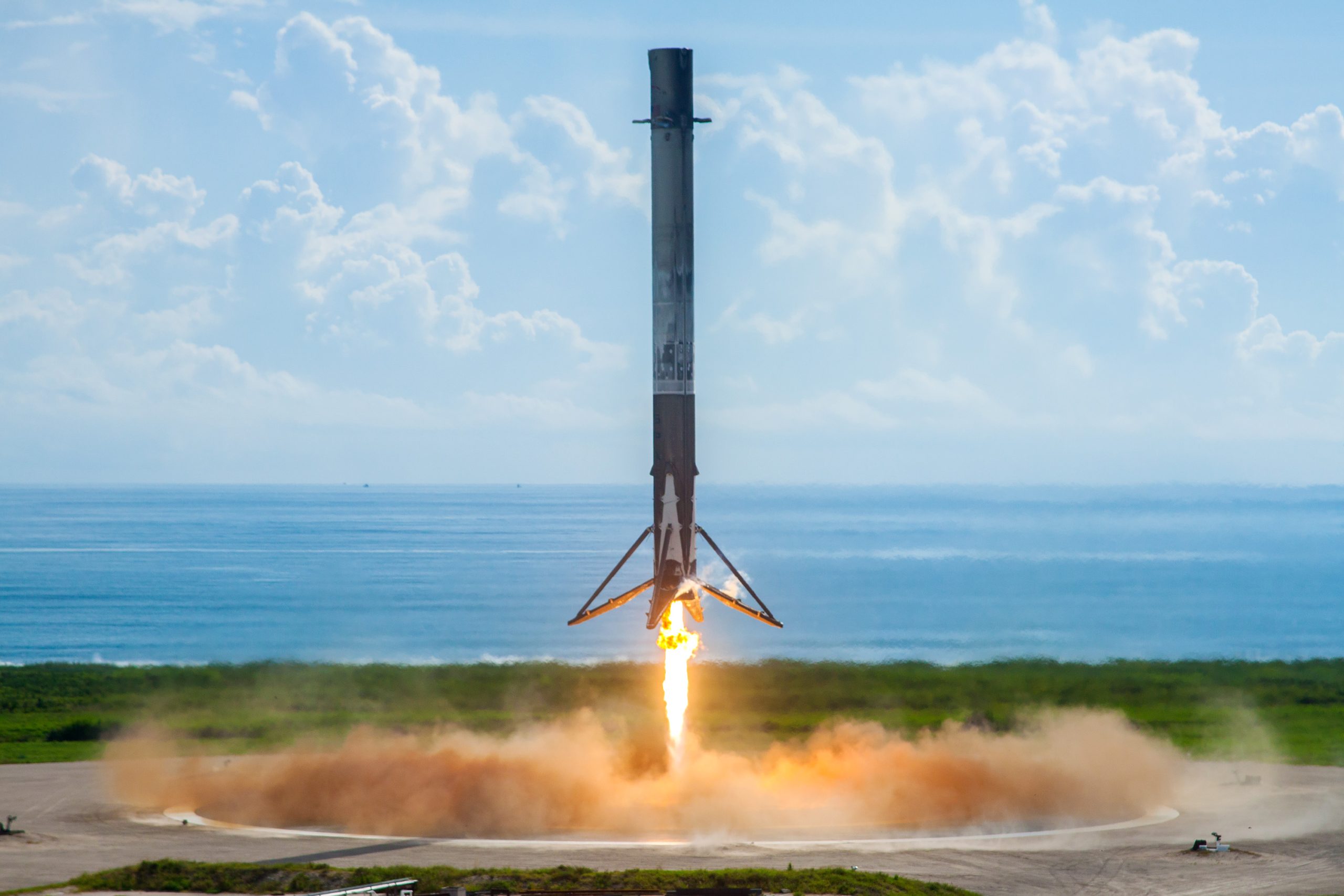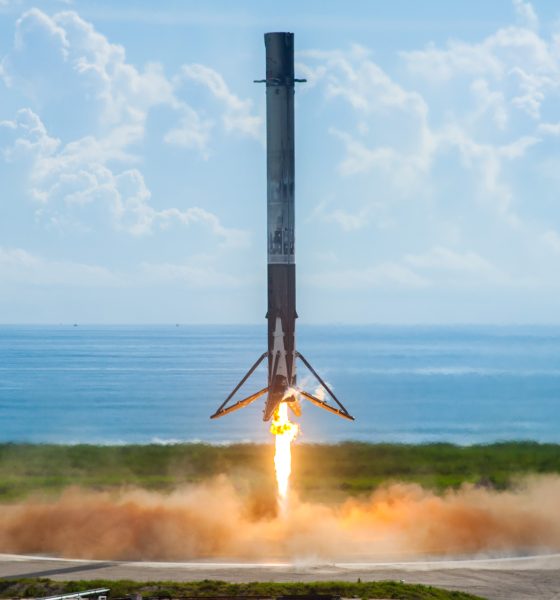

News
SpaceX aims for two launches in two days, droneship robot spotted again
NASASpaceflight.com has reported that two SpaceX launches have slipped five days, with SES-11 and Iridium NEXT-3 respectively scheduled for launch on October 7th and 9th. Initially planned for October 2nd and 4th, the concurrent delays mean SpaceX will still attempt to conduct two launches within approximately 48 hours of each other.
We expect the Falcon 9 launch with the third set of Iridium NEXT satellites from Vandenberg to be NET Oct. 9. Philip Sloss (NSF) IR-2 photo. pic.twitter.com/rv7FoM5ZbC
— NSF – NASASpaceflight.com (@NASASpaceflight) September 25, 2017
Earlier this summer, SpaceX managed to successfully launch three Falcon 9 missions in just 12 days, with two of those launches and booster recoveries occurring in less than 48 hours. As such, the company has readily demonstrated its ability for rapid-fire launch cadence and a willingness to schedule missions as few as 24 hours apart, if necessary.
While SpaceX is only able to intermittently achieve such a cadence, their ability to launch rapidly will likely mature as LC-40 is reactivated and the company finds itself with three active launch pads. This is the only way SpaceX can achieve a planned cadence of weekly launches by 2019, and it would also help the company conduct several dozen potential launches next year, 28 of which presently have tentative launch dates in 2018.
If all goes according to plan, the second week of October will see two Falcon 9 vehicles launch satellites into Earth orbits and then return to their respective oceans for recovery aboard both of SpaceX’s autonomous droneships; Just Read The Instructions in the Pacific, and Of Course I Still Love You in the Atlantic.
Of Course I Still Love You‘s mythical robotic companion was spotted out and about aboard the droneship earlier this week by Julia Bergeron, an active SpaceX fan and resident of Florida’s Space Coast. More exciting still, the launch of SES-11 will be the second time the telecommunications company has chosen to fly on a refurbished Falcon 9, and SpaceX’s third commercial reuse of an orbital-class rocket.
I went to @PortCanaveral to visit @SpaceX #OCISLY since it's been a while. I was greeted with autonomous open arms. Yes, we miss you too! pic.twitter.com/9dPDSjpwkd
— Julia Bergeron (@julia_bergeron) September 22, 2017
SpaceX’s next Eastern mission, Koreasat 5A, may be pushed back at least several days from its tentative October 14th launch date due to the aforementioned delays. SES-11 may be the last launch from the LC-39A launch facility for some time, requiring Koreasat 5A to launch from SpaceX’s second Eastern pad, LC-40. LC-39A needs a hiatus from launch activities for at least several weeks to give SpaceX’s pad engineers time needed to modify the facility for Falcon Heavy. Extensive on-pad testing for Falcon Heavy will precede its inaugural launch attempts, and that process will demand a level of flexibility that an operational launch facility simply could not support over a period of several weeks or months.
Still, SpaceX is unlikely to allow Falcon Heavy to seriously intervene with or delay its customers’ launches, and evidence of LC-40 nearing launch readiness is currently hard to find. SpaceX employees are reportedly busy assembling and outfitting the Transporter/Erector/Launcher (TEL) that will allow for launches to begin again at the newly repaired pad, but a significant amount of work remains. If LC-40 ends up requiring more time to reach operational status, LC-39A will undoubtedly continue to support commercial launches until it can be seamlessly replaced. A slower reactivation of LC-40 will also inevitably result in delays of some sort to Falcon Heavy’s inaugural launch date, pushing the massive rocket’s first liftoff well into December 2017 or the first few months of 2018.

Elon Musk
Elon Musk and Tesla AI Director share insights after empty driver seat Robotaxi rides
The executives’ unoccupied tests hint at the rapid progress of Tesla’s unsupervised Robotaxi efforts.

Tesla CEO Elon Musk and AI Director Ashok Elluswamy celebrated Christmas Eve by sharing personal experiences with Robotaxi vehicles that had no safety monitor or occupant in the driver’s seat. Musk described the system’s “perfect driving” around Austin, while Elluswamy posted video from the back seat, calling it “an amazing experience.”
The executives’ unoccupied tests hint at the rapid progress of Tesla’s unsupervised Robotaxi efforts.
Elon and Ashok’s firsthand Robotaxi insights
Prior to Musk and the Tesla AI Director’s posts, sightings of unmanned Teslas navigating public roads were widely shared on social media. One such vehicle was spotted in Austin, Texas, which Elon Musk acknowleged by stating that “Testing is underway with no occupants in the car.”
Based on his Christmas Eve post, Musk seemed to have tested an unmanned Tesla himself. “A Tesla with no safety monitor in the car and me sitting in the passenger seat took me all around Austin on Sunday with perfect driving,” Musk wrote in his post.
Elluswamy responded with a 2-minute video showing himself in the rear of an unmanned Tesla. The video featured the vehicle’s empty front seats, as well as its smooth handling through real-world traffic. He captioned his video with the words, “It’s an amazing experience!”
Towards Unsupervised operations
During an xAI Hackathon earlier this month, Elon Musk mentioned that Tesla owed be removing Safety Monitors from its Robotaxis in Austin in just three weeks. “Unsupervised is pretty much solved at this point. So there will be Tesla Robotaxis operating in Austin with no one in them. Not even anyone in the passenger seat in about three weeks,” he said. Musk echoed similar estimates at the 2025 Annual Shareholder Meeting and the Q3 2025 earnings call.
Considering the insights that were posted Musk and Elluswamy, it does appear that Tesla is working hard towards operating its Robotaxis with no safety monitors. This is quite impressive considering that the service was launched just earlier this year.
Elon Musk
Starlink passes 9 million active customers just weeks after hitting 8 million
The milestone highlights the accelerating growth of Starlink, which has now been adding over 20,000 new users per day.

SpaceX’s Starlink satellite internet service has continued its rapid global expansion, surpassing 9 million active customers just weeks after crossing the 8 million mark.
The milestone highlights the accelerating growth of Starlink, which has now been adding over 20,000 new users per day.
9 million customers
In a post on X, SpaceX stated that Starlink now serves over 9 million active users across 155 countries, territories, and markets. The company reached 8 million customers in early November, meaning it added roughly 1 million subscribers in under seven weeks, or about 21,275 new users on average per day.
“Starlink is connecting more than 9M active customers with high-speed internet across 155 countries, territories, and many other markets,” Starlink wrote in a post on its official X account. SpaceX President Gwynne Shotwell also celebrated the milestone on X. “A huge thank you to all of our customers and congrats to the Starlink team for such an incredible product,” she wrote.
That growth rate reflects both rising demand for broadband in underserved regions and Starlink’s expanding satellite constellation, which now includes more than 9,000 low-Earth-orbit satellites designed to deliver high-speed, low-latency internet worldwide.
Starlink’s momentum
Starlink’s momentum has been building up. SpaceX reported 4.6 million Starlink customers in December 2024, followed by 7 million by August 2025, and 8 million customers in November. Independent data also suggests Starlink usage is rising sharply, with Cloudflare reporting that global web traffic from Starlink users more than doubled in 2025, as noted in an Insider report.
Starlink’s momentum is increasingly tied to SpaceX’s broader financial outlook. Elon Musk has said the satellite network is “by far” the company’s largest revenue driver, and reports suggest SpaceX may be positioning itself for an initial public offering as soon as next year, with valuations estimated as high as $1.5 trillion. Musk has also suggested in the past that Starlink could have its own IPO in the future.
News
NVIDIA Director of Robotics: Tesla FSD v14 is the first AI to pass the “Physical Turing Test”
After testing FSD v14, Fan stated that his experience with FSD felt magical at first, but it soon started to feel like a routine.

NVIDIA Director of Robotics Jim Fan has praised Tesla’s Full Self-Driving (Supervised) v14 as the first AI to pass what he described as a “Physical Turing Test.”
After testing FSD v14, Fan stated that his experience with FSD felt magical at first, but it soon started to feel like a routine. And just like smartphones today, removing it now would “actively hurt.”
Jim Fan’s hands-on FSD v14 impressions
Fan, a leading researcher in embodied AI who is currently solving Physical AI at NVIDIA and spearheading the company’s Project GR00T initiative, noted that he actually was late to the Tesla game. He was, however, one of the first to try out FSD v14.
“I was very late to own a Tesla but among the earliest to try out FSD v14. It’s perhaps the first time I experience an AI that passes the Physical Turing Test: after a long day at work, you press a button, lay back, and couldn’t tell if a neural net or a human drove you home,” Fan wrote in a post on X.
Fan added: “Despite knowing exactly how robot learning works, I still find it magical watching the steering wheel turn by itself. First it feels surreal, next it becomes routine. Then, like the smartphone, taking it away actively hurts. This is how humanity gets rewired and glued to god-like technologies.”
The Physical Turing Test
The original Turing Test was conceived by Alan Turing in 1950, and it was aimed at determining if a machine could exhibit behavior that is equivalent to or indistinguishable from a human. By focusing on text-based conversations, the original Turing Test set a high bar for natural language processing and machine learning.
This test has been passed by today’s large language models. However, the capability to converse in a humanlike manner is a completely different challenge from performing real-world problem-solving or physical interactions. Thus, Fan introduced the Physical Turing Test, which challenges AI systems to demonstrate intelligence through physical actions.
Based on Fan’s comments, Tesla has demonstrated these intelligent physical actions with FSD v14. Elon Musk agreed with the NVIDIA executive, stating in a post on X that with FSD v14, “you can sense the sentience maturing.” Musk also praised Tesla AI, calling it the best “real-world AI” today.








